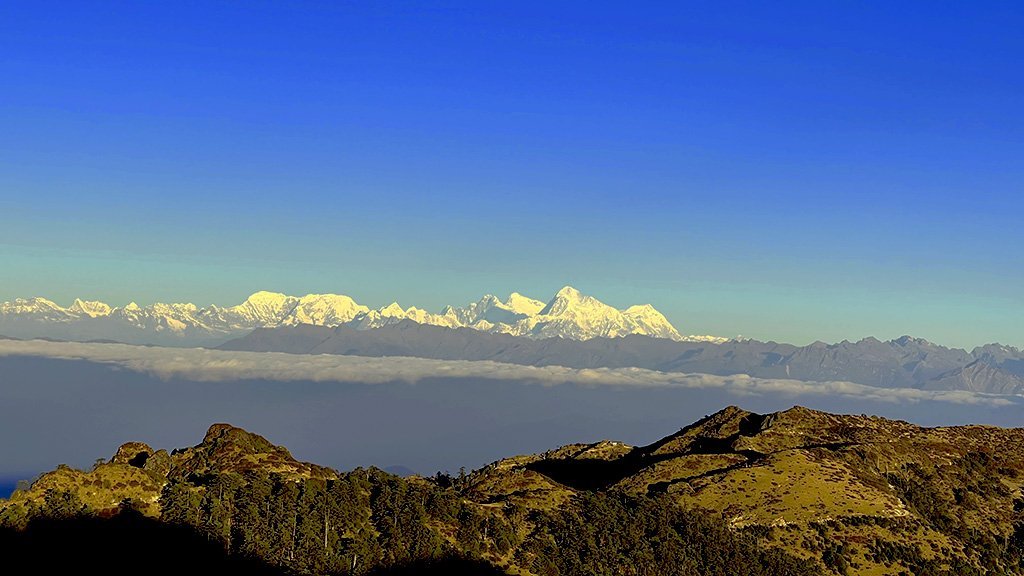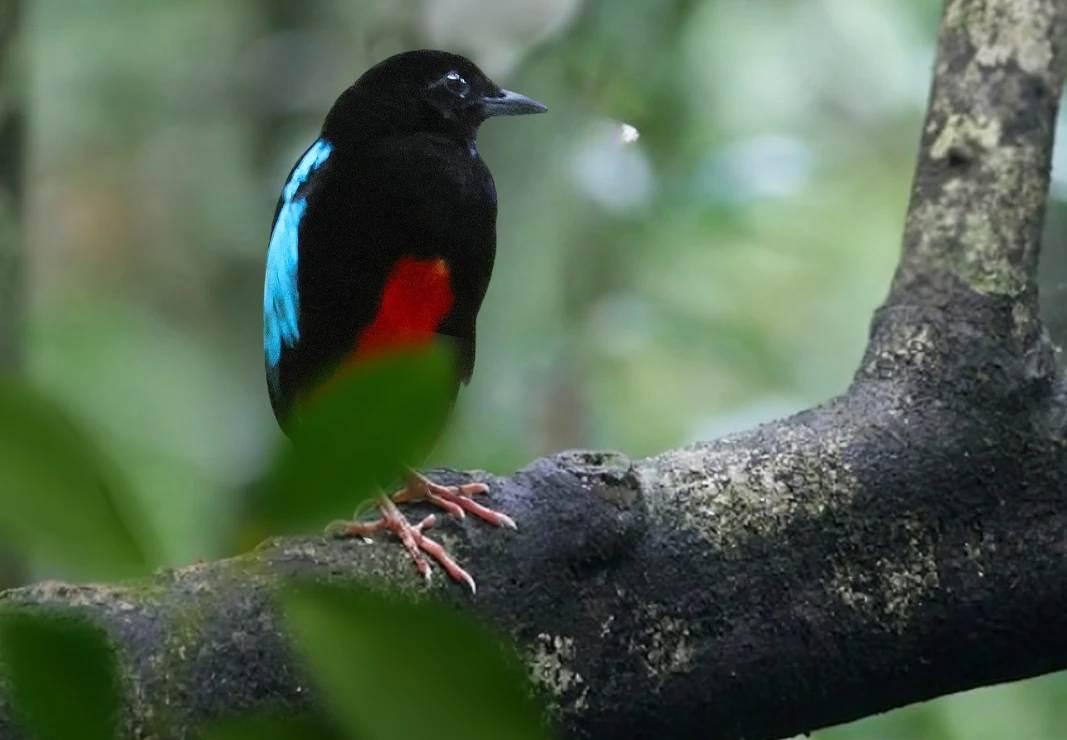Red Panda of Himalayas
Home › Red Panda of Himalayas
Master Shifu — the strict mentor from Kung Fu Panda — might still be fresh in your memory. What many do not realise is that he is based on a real animal: the red panda. Adorably small, reddish-brown, and full of character, the red panda features in many Himalayan folk tales and was, in fact, the original bearer of the name “panda” — long before the giant panda came into the picture. Unlike the bear-like giant panda, the red panda is a separate species altogether. To me, it is the real panda. And that was reason enough to track it in Singalila.
The Red Panda is a small, tree-dwelling mammal, about three to four times the size of a fluffy Persian cat. It has dense reddish-brown fur, a long bushy tail with faint rings, and a gentle, almost curious expression that makes it instantly likeable. Found only in the temperate forests of the eastern Himalayas and parts of southwestern China, the red panda spends most of its time in trees, moving slowly and quietly through the branches. Its main diet is bamboo, but it also eats berries, acorns, and the occasional bird egg or insect. For many years, people believed it was a smaller version of the giant panda and placed it in the bear family. However, recent DNA studies have revealed that it belongs to its own unique family and is more closely related to raccoons and weasels. It is a species with no close relatives — a living remnant of an ancient evolutionary line.
How to locate a Red Panda in the Himalayan region In India?
The red panda lives in remote, elevated forests across the Himalayan region, including parts of India, Nepal, Bhutan, and China. These animals are naturally quiet and secretive, spending most of their time alone among thick trees and bamboo undergrowth. Their reddish fur blends well with moss-covered branches and filtered mountain light, making them difficult to spot — let alone photograph. For wildlife photographers and nature enthusiasts, finding one in the wild requires patience, local knowledge, and a fair bit of luck. Though several national parks and reserves now serve as protected habitats, red pandas still face serious threats. Poaching, deforestation, livestock grazing, and fragmented habitats have pushed their numbers down over the years. Current estimates suggest that fewer than 10,000 individuals remain in the wild, and that figure is declining steadily. Due to these ongoing threats, the red panda has been classified as “Endangered” by the United Nations and international conservation bodies
Red Panda Expedition: Is this an act of animal cruelty?
Red panda photography tours are among the most demanding wildlife expeditions in the Himalayas, often compared to snow leopard tracking in terms of difficulty and patience required. Despite the challenges, red panda tourism has seen remarkable growth, especially in Nepal and India. In December 2021, I had the opportunity to lead Endemic Explorer’s first red panda expedition following the pandemic — a small but meaningful step as travel slowly resumed. While I have seen increasing interest and promotional content about red panda tours in China, particularly in Yunnan and Sichuan, concrete data on the scale of tourism there remains unclear. What is heartening is the shift in local participation — many former poachers have now become responsible guides and trackers, playing a key role in red panda conservation. However, the question remains: is the growing tourism pressure impacting these shy, solitary animals? I believe it is time to regulate these expeditions and keep their scale in check, before admiration turns into intrusion.
Tracking down a Rad Panda - A stressful exercise
In red panda tracking tours, the day begins early. The trackers head out at dawn, while guests stay back at camp with the guide. Groups are kept small — usually three to five people — to minimise disturbance. The trackers spread out across the rhododendron and bamboo-covered slopes, scanning the trees for signs of red pandas. When one is spotted, usually resting on a branch, the trackers quietly surround the tree to prevent the panda from descending and moving on. Unlike monkeys or leopards, red pandas cannot leap from one tree to another; they must climb down to the ground before finding their next perch. Once the animal is located, one tracker alerts the camp, either by phone or by returning on foot, and the guide then escorts the guests to the site. If the panda is far from camp or the terrain is steep, this process can take hours. Meanwhile, the panda remains stuck, quietly waiting — for us.
Singalila National Park and Red Panda Expeditions
Singalila National Park, straddling the border between India and Nepal, is considered one of the best places in the world to see red pandas in the wild. The Indian portion of the park lies mainly in the Darjeeling district of West Bengal — a region already well-known for its tea, colonial-era charm, and cool mountain air. The district’s capital, also called Darjeeling, serves as the main access point for travellers heading into the park. Singalila sits at elevations between 7,400 and 12,000 feet and offers stunning views of snow-capped Himalayan peaks on clear days. While the red panda is the star attraction for many, the park is also a favourite among trekkers and bikers, thanks to its winding trails, ridge-top pathways, and remote campsites. Birdwatchers also flock here, drawn by species such as the Blood Pheasant and Satyr Tragopan. It is a place where nature, adventure, and quiet observation meet.
How can you reach Singalila National Park in India?
We flew into Bagdogra Airport via Kolkata on a pleasant December morning. The crisp winter air and clear skies made for a smooth landing in Siliguri, West Bengal — the nearest and most convenient airport for reaching Singalila National Park. Travellers also have the option of arriving by overnight train from Kolkata, but we chose the quicker route by air. From Bagdogra, it is a 5 to 6-hour drive to the park, depending on the road and weather conditions. The journey winds through beautiful tea gardens, quiet villages, and misty valleys until you reach Maneybhanjang, a small hill town sitting at 7,054 feet. The road up to this point is scenic and relatively easy. From here, however, you must switch to a local 4×4 vehicle and obtain park permits. We made sure to arrive before the 2 PM cut-off, as park authorities only allow vehicles entry before that time. Thankfully, our guide had arranged the permits in advance.
Land Rovers of Maneybhanjang: A moving British heritage of the Himalayas
The most striking and endearing feature of Maneybhanjang — the gateway village to Singalila National Park — is not its location or the views, but its fleet of vintage Land Rovers. These grand old vehicles are the pride of the village. Originally brought to the Himalayas in the 1930s and 1940s to serve British tea estates, the Land Rovers remained behind long after the British left. Today, they stand as living relics of a bygone era, still rumbling up and down the steep slopes of Singalila. The villagers treat them with great respect, maintaining them with care and deep affection.
My driver proudly told me that around 40 of these Land Rovers are still in active service — most of them more than 60 years old. Riding in one of them is not just a necessity; it is an experience in itself. If you are visiting the park, you must consider hiring one for your journey into the hills.
Tumling (India) and Kayyakatta (on the India-Nepal border) are two of the most reliable areas within Singalila National Park for spotting red pandas. Both sites lie within known panda territories, with elevations, bamboo forests, and dense undergrowth that these animals prefer. We stayed in Gairibas, a quiet little village with a few homestays, simple but comfortable, and well-positioned for daily excursions into the forest. From there, Kayyakatta was just about 5 kilometres away — close enough to reach every morning but remote enough to feel truly wild.
For four nights, we made the same routine: set out early, drive up in a 4×4, and then begin walking with the help of local trackers. These men, most of them from the surrounding villages, are experts in this terrain. They can read the forest in a way that outsiders simply cannot. They searched while we waited, followed trails, and called in when they found signs. The first two days passed without a sighting. But on the third, after a steep 4 km climb through slippery bamboo slopes, one tracker signalled success. And there he was — a male red panda, resting calmly at eye level. That moment, quiet and real, remains one of my most cherished in the wild.
Himalayan Wildlife Expedition guides
The quality of your guide will largely determine the success of a red panda expedition. This is not a typical wildlife tour — it demands strong local knowledge, coordination, and patience. A well-connected guide with access to reliable trackers can significantly improve your chances of locating a red panda. If you do not speak Hindi or Bengali, make sure your guide is comfortable communicating in English. Clear communication is essential, especially when navigating remote terrain and responding quickly to sightings.
Accommodation is another important consideration. Conditions in Singalila are basic, so before confirming your stay, specifically ask about hot water, heating (wood stoves or electric), and toilet facilities. These vary widely and can affect your comfort, especially in cold months. For our expedition, we worked with our trusted local handlers, who regularly partner with Endemic Explorer for Sikkim and West Bengal expeditions. They arranged the guides, permits, and accommodation, making the entire experience smoother, even in a rugged and remote setting.
Accommodations in Singalila National Park In India
The quality of lodging in this region has traditionally been the most uncomfortable part of a red panda expedition. While the forests are pristine and the wildlife encounters unforgettable, accommodation in the mountains can be very basic. Toilets are often in disrepair, hot water is limited, and no proper heating systems are available — even when night temperatures drop to near freezing. During the best seasons for red panda tracking, from October to December and March to early May, temperatures typically range from 12°C during the day to as low as 1°C at night. For birders, April is particularly rewarding, with several rare Himalayan species active at that time.
If you are not used to rough conditions, it is important to speak with your guide in advance and understand the limitations. As an alternative, you could stay in Darjeeling and make day trips to Tumling or Kayyakatta. Recently, Endemic Explorer has made arrangements with a few colonial-era tea garden bungalows and estates, offering a more comfortable stay with improved facilities — a welcome upgrade for those who prefer warmth, reliable amenities, and a touch of history after a long day in the field.

Another recommended destination nearby is Sandakphu, the highest point in West Bengal. It is about a two-hour drive from Gairibas and well worth the effort if you have an extra day. The drive takes you along ridges with dramatic drops on either side, and if the skies are clear, you are rewarded with panoramic views of four of the five highest peaks in the world — including Mount Everest, Lhotse, Makalu, and the unmistakable massif of Kanchenjunga. Sandakphu is a popular stop among trekkers, photographers, and nature lovers alike, and offers a breathtaking finale to your Singalila journey.
So, are you ready? Singalila is calling. The bamboo forests, rhododendron trails, and the elusive red panda are waiting. Whether you come for the wildlife, the walking, or the view from Sandakphu, your moment in these quiet mountains is out there — and it is worth every step.
This journey was part of our carefully crafted expeditions at Endemic Explorer — a theme-based travel company committed to meaningful nature and heritage experiences. We operate across remote regions of Asia, Africa, and Latin America, partnering with local communities to create immersive, responsible travel. Whether it is birdwatching in the Western Ghats, tracking red pandas in the Himalayas, or exploring ancient cultures in South America, each of our journeys is designed for those who seek more than sightseeing. To learn more about our wildlife and photography tours across India and beyond, visit www.endemicexplorer.com.
Latest Post

Papua New Guinea Bird Photography Tour Report – 2024

Chasing the Super Pitta: A Journey to Manus Island


